|
Sewing Machine Needles – Choosing The Right Needle For The Project
Choosing the right sewing machine needles for a project, especially for sewing machine projects really is important. There are different needles recommended for machine sewing, hand sewing, quilting, embroidery and serging.
The choice of needle should match the fabric weight and fiber content. Sewing machine needles for machine sewing look different and are more complex than needles for hand sewing and have more components than needles for hand sewing. Certain of these components are the determining factor as to what needle is chosen for what fabric.
Parts of the Needle:
• Shank – the larger part of the needle that is inserted into the needle bar. The back of the needle is flat, which helps in the correct insertion of the needle. The flat portion of the needle is inserted facing the back of the machine. • Shaft – the smaller thinner part of the needle that goes through the fabric during stitching by the machine. • Groove- the indentation on the shaft of the needle on which the thread lays. • Eye – the hole of the needle through which the needle is threaded. • Point – the tip of the needle, and the part of the needle which determines what needle should be used for what fabric


Although needles for hand sewing come in different sizes with different eye sizes, it is the needle point that must be considered along with the eye size when choosing appropriate sewing machine needles.
Needle Sizes:
Sewing machine needles sizes are determined according to both the American and/or European system of sizing. Generally both numbers will be given.
European sizes are: 60, 70, 80, 90, 100, and 110
American sizes are: 8, 10, 12, 14, 16, and 18
When packages list both sizes, the European size is written over the American size and looks like a fraction. For example: 60/8, 70/10, 80/12, 90/14, 100/16, and 110/18. A good rule of thumb to remember is that the smaller the number, the finer the needle. In addition, the finer the fabric, the smaller the needle size needs to be, to reduce the stress on the fabric.
Another rule of thumb is that the needle should be changed after each sewing project.


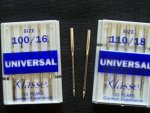
Selecting the Right Needle for the Fabric:
All fabrics are either wovens or knits
For Woven Fabrics:
For feather weight and very light weight fabrics such as: batiste, chiffon, fine lace, voile, organza, georgette, transparent fabrics, and microfibers
• Needle types: sharps, universals • Needles sizes: 60/8 and 70/10 For lightweight fabrics such as: challis, chambray, charmeuse, crepe, dotted swiss, satin, lace, taffeta
• Needle types: sharps, universals • Needle sizes: 60/8 and 70/10 For lightweight to medium weight fabrics such as: metallics, gingham, percale, seersucker
• Needle types: sharps, universals • Needle sizes: 60/8, 70/10, and 80/12 For medium weight fabrics such as: broadcloth, brocade, pique, Shantung, silk suiting, chinz, faille, felt, polyester blends, acrylics, woolens, worsteds, washable wools, fleece, gabardine, outerwear
• Needle types: sharps, universals • Needle sizes: 70/10, 80/12, and 90/14 For medium weight to heavy weight fabrics such as: denim, twill weave fabric, corduroy, terry cloth, velour, faux fur
• Needle types: sharps, denim, universals • Needle sizes: 70/10, 80/12, 90/14 and 100/16 For heavy weight fabrics such as: canvas, coatings, duck
• Needle types: sharps, universals • Needle sizes: 80/12, 90/14, and 100/16
For Knit Fabrics:
For lightweight fabrics such as: double knit, interlock, jersey, mesh, panne, velvet, rib knit
• Needle types: universals and stretch • Needle sizes: 60/8, and 70/10
For light to medium weight fabrics such as: velour, fleece, sweater knits, sweat shirt knits
• Needle types: universals, stretch, and ballpoint • Needle sizes: 60/8, 70/10, and 80/12
Formedium to heavy weight fabrics such as: faux fur, double knit, and fleece
• Needle types: universals, stretch and ballpoint • Needle sizes: 70/10, 80/12, 90/14, and 100/16
In general universal needles can be used with any type of fabric, sharps needles should be used with woven fabrics, ballpoint needles should be used with knit fabrics, and stretch needles should be used with fabrics that have stretch. Specialty needles such as denim needles should be used for jeans, leather needles for leather, and embroidery needles for embroidery stitching, and quilting needles for quilt making.
Using the correct sewing machine needles will alleviate a lot of stitching headaches and result in a better stitch quality.



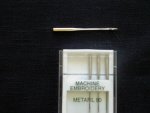
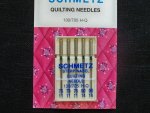
It is also important to choose appropriate hand sewing needles for either hand sewing projects or for those portions of machine sewing projects that may require hand stitching. If hand sewing through multiple layers or thick fabrics, darning needles may be a good choice.


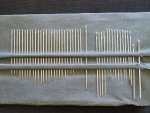

A handy little accessory for threading those sewing machines that do not have an automatic needle thread, but especially made for threading hand sewing needles is a needle threader.

An important handy tool that will protect the fingers from needle pricks during hand sewing is a thimble - a must have little tool.
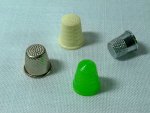
For more excellent information about choosing the right sewing machine needles for stitching, see this source reference.
Claire Shaeffer’s Fabric Sewing Guide
For more interesting information about sewing machine needles click here on About.com
Sewing Thread Page
|




